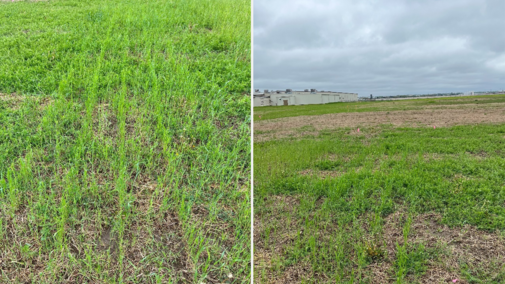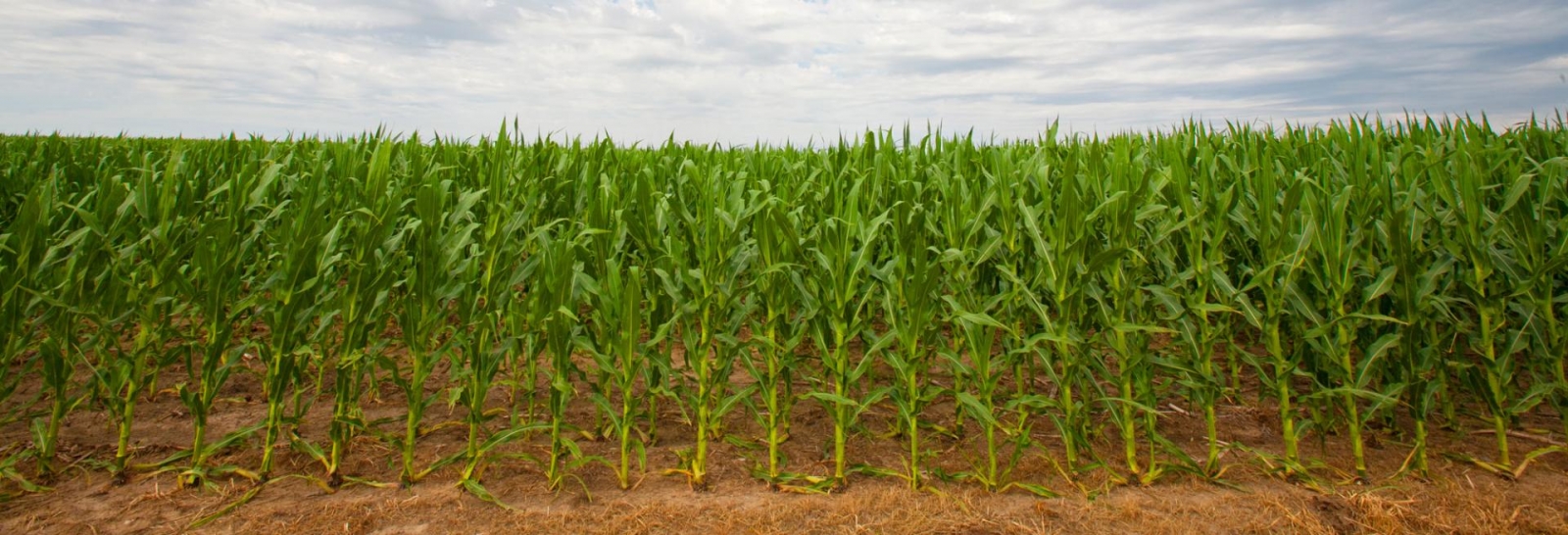Key Takeaways
Drilling is the most effective planting method for cover crops, consistently showing better germination and growth compared to broadcasting.
Choosing the right cover crop and planting method matters. Farmers should select species and planting techniques based on their specific soil health and management goals.
Elbon rye is a top performer, making it a reliable choice for farmers seeking high cover crop productivity. However, combining cover crop species provides additional benefits for maximizing long-term soil improvement.
Although a large emphasis of cover crop research at the University of Nebraska is related to row crop agriculture, the same goals and benefits for their use can apply to horticultural crops. However, the specific management approaches for cover crops can vary based on the scale and farming systems under which they are being utilized.
Community Crops, a non-profit organization in Lincoln, has been supporting local farmers and gardeners who produce food for more than two decades. Their farming spaces include not only a series of community gardens across Lincoln, but also a few larger areas of land that serve as “incubators” to help beginning farmers increase production and access local food markets. This includes 12 acres of land leased by Airport Authority beginning in 2021, one goal of which is to improve the soil in areas that are not yet utilized by the beginning farmers.
Given its proximity to Lincoln and our team’s recent experiences with cover crop variety testing, in fall 2022, we launched a pilot experiment to ensure planting equipment success through establishing several acres of demonstration cover crops. Then, in 2023, we launched a more formal experiment with a goal evaluating the establishment and productivity of various winter cover crops using two planting methods: broadcasting and drilling. By demonstrating effective cover crop management strategies, these results can support more effective cover crop use at this location and in general for local farmers and food growers.
Different planting methods play a critical role in determining cover crop growth and development. Drilling, which places seeds directly into the soil, typically results in higher germination rates due to improved seed-soil contact, leading to better early establishment. Broadcasting, on the other hand, is faster and requires less specialized equipment. But broadcasting may lead to uneven seed coverage and/or reduced germination due to poor seed-soil contact and greater exposure to environmental factors such as limited rain.
Experimental Design
The experimental design followed a split-plot arrangement of treatments with three replications. The main plots tested two planting methods — drilling and broadcasting — while the split plots tested 10 cover crop species and varieties.
The cover crop species and varieties included three rye varieties (Elbon, Hazlet, and Yankee), triticale (Montech), two wheat varieties (Gore and Goodstreak), two hairy vetch varieties (NE and AU-Merit), and two mixtures: Elbon rye + AU-Merit hairy vetch (Mix-I) and Montech triticale + AU-Merit hairy vetch (Mix-II). The species and varieties were chosen for their potential adaptability to local conditions and their greater performance at the team’s fall-planted experiments in 2022-2023 across the state of Nebraska.
The cover crops were planted on Oct. 4, 2023, and field measurements were taken on May 2, 2024, to assess plant height, ground cover, and aboveground biomass production. Plant height was measured from ground level to the top of the tallest extended leaf. Ground cover was estimated using the CANOPEO mobile app. Biomass production was evaluated by harvesting all aboveground vegetation within a quadrat measuring 0.6 m × 0.3 m. The collected biomass was oven-dried at 65°C for one week and the final dry weight was recorded.
The site received 18.3 mm of precipitation one day before planting and 12 mm within the first two weeks after planting. During the initial growth period (Oct. 4 to Dec. 31, 2023), total precipitation was 75.3 mm (approximately three inches). Over the entire growing season, from planting to termination, precipitation totaled 243 mm (approximately 10 inches).
| Species | Drill rate (kg/ha) | Drill rate (lbs./ac) | Broadcast rate (kg/ha) | Broadcast rate (lbs./ac) |
| Hairy vetch | 22.4 | 20.0 | 33.6 | 30.0 |
| Mixtures | 56.0 (grass) + 16.8 (legume) | 50.0 (grass) + 15.0 (legume) | 67.3 (grass) + 28.0 (legume) | 60.0 (grass) + 25.0 (legume) |
| Rye | 84.1 | 75.0 | 112.1 | 100.0 |
| Triticale | 84.1 | 75.0 | 112.1 | 100.0 |
| Wheat | 84.1 | 75.0 | 112.1 | 100.0 |
Results
A key finding from this trial was the significant difference in establishment between the two planting methods. The broadcast plots had almost no germination, likely due to insufficient seed-to-soil contact, which severely limited establishment and growth. Although within the reliable establishment window for the winter cover crop species selected, the first week of October might be later than ideal for broadcasting cover crops, and it might also be possible for some farmers to broadcast plant cover crops earlier than this timing. As a result, no meaningful data could be collected from these plots.
Also, adequate rainfall at or shortly after planting is recognized as critical for establishment of broadcast cover crops. However, from our experience, the rainfall received at the site —approximately one inch near to planting, and three inches in the fall — may not have been the most limiting factor for growth in the broadcast treatments.
In contrast, the drilled plots consistently achieved strong growth across all tested varieties, confirming drilling as a reliable approach for promoting cover crop establishment.
Elbon rye exhibited the highest average plant height (49.1 cm), significantly taller than most other varieties, while AU-Merit and NE hairy vetch had the shortest plant height (<16 cm) (Figure 1). Ground cover ranged from 21% (Montech triticale) to 36% (Elbon rye), with no significant variation across varieties (Figure 2). Elbon rye produced the highest biomass (1088 kg/ha), followed closely by AU-Merit hairy vetch (1052 kg/ha), with no significant difference between them (Figure 3). Montech triticale produced the least biomass (472 kg/ha) (Figure 3).

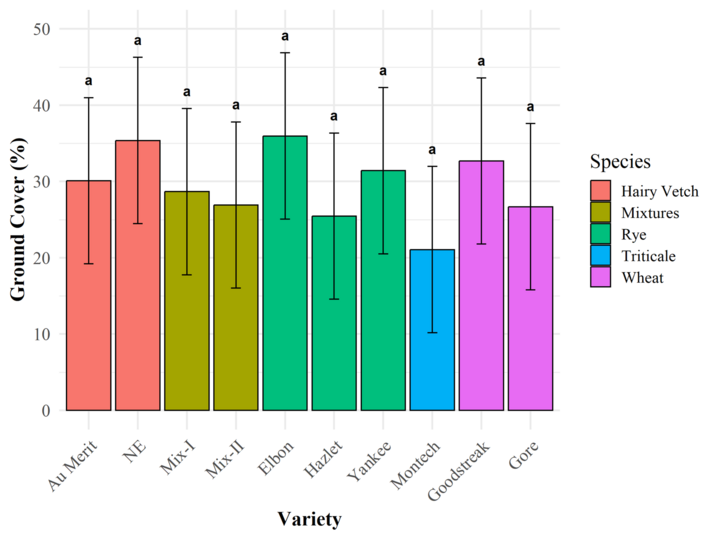
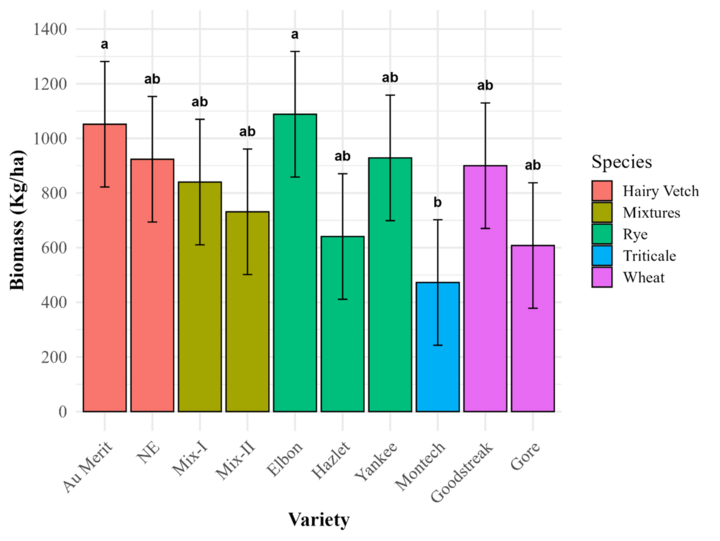
Biomass production for other varieties, including mixtures, was comparable and did not significantly differ from the top performers (Figure 3). Notably, volunteer areas of hairy vetch, we believe from the demonstrations planted the prior year, in two of the three replications of the experiment, influenced ground cover and biomass results (Figures 4 and 5).
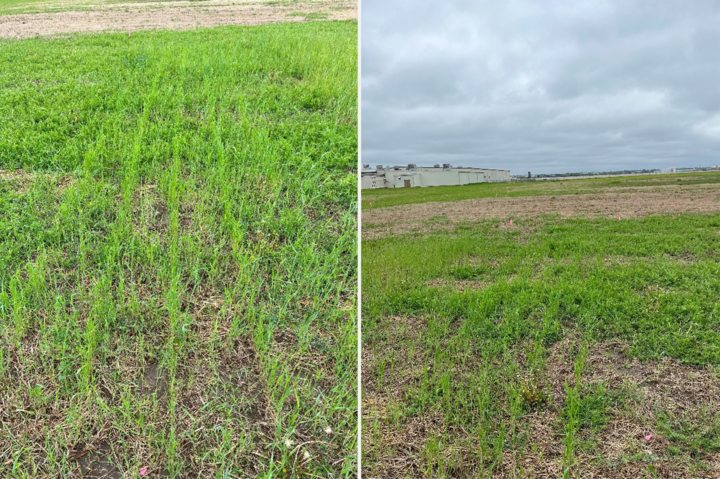
Conclusion
The results emphasize the importance of selecting appropriate cover crop species and planting methods to achieve desired agricultural outcomes. Drilling consistently resulted in better germination and growth, making it the preferred method for successful cover crop establishment. Elbon rye emerged as a top-performing variety, excelling in both plant height and biomass production, making it a reliable choice for farmers seeking robust cover crop productivity.
While Elbon rye demonstrated superior biomass and growth, other species, such as mixtures and hairy vetch, provide additional benefits, including nitrogen fixation and faster nutrient release, which are valuable for improving soil fertility. Farmers may consider combining species to maximize benefits, such as improved soil health and reduced nutrient loss, depending on their specific needs and management goals.
